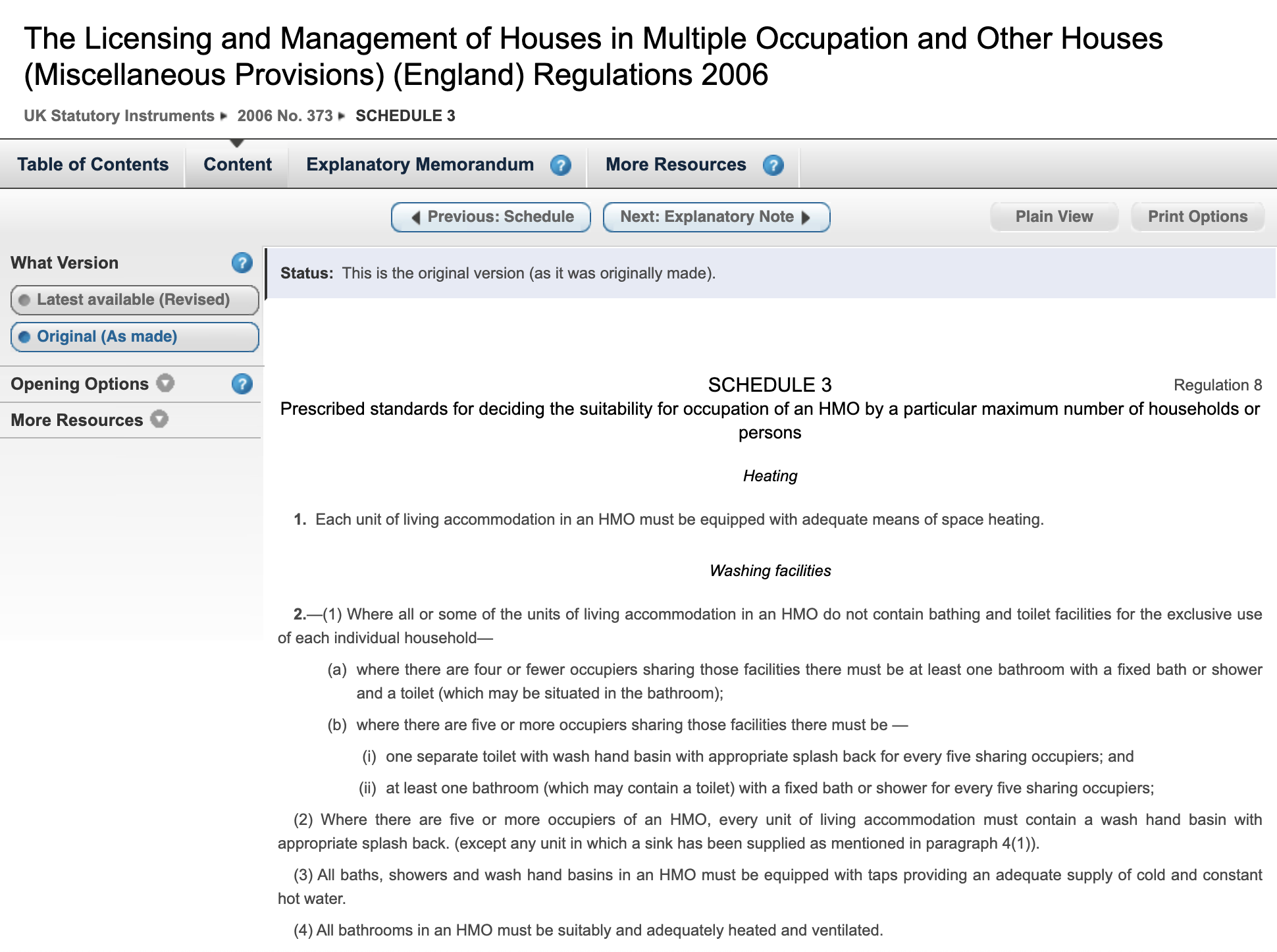This post is all about HMO investing (also known as houses of multiple occupancy) – what they are, why anyone would want to live in one, and, most importantly, why you may want to consider investing in them.
The days of grotty ‘bedsit-style’ student houses are thankfully becoming a distant memory.
More modern shared living is becoming increasingly popular with property investors and tenants alike, so it’s important to understand exactly what they are and how they work.
We’ll be looking at:
So let’s get started.
HMO Investing: What is a HMO?
The simplest definition of an HMO is a shared house – multiple people living together and sharing a space who don’t form a single family unit.
But depending on where you look or who you’re talking to, you might come across various definitions:
The government definition of an HMO is any residential property occupied by three or more tenants who form two or more households, and who share basic amenities like a kitchen or bathroom.
This even means that a couple who rent out a spare room to an unrelated 3rd person is technically creating an HMO!
Typically though, for HMO investing purposes, we’re talking about properties where the owner lives elsewhere and rents out all of the bedrooms to unrelated tenants.
Licensable HMOs
An HMO becomes licensable when five or more tenants are living in the property. HMO licensing means that the property is subject to extra safety standards and inspections, and the landlord must have a license from the local authority to operate one.
Some local authorities also operate further licensing schemes for rental property, which include additional licensing and selective licensing.
Additional licensing is like Mandatory HMO licensing, but it applies to all HMOs in a designated area – not just those with five or more occupants.
Selective licensing is similar, but can to any rental property in a particular area – for example, all privately rented houses or all flats in a certain postcode.
It sounds complicated, but a quick google search can tell you all you need to know about the licensing requirements for rental property in your area.
The main thing to keep in mind at this stage is that all HMOs in England with 5 or more occupants require a mandatory HMO licence.
Many local authorities have introduced Additional Licensing for smaller HMOs as well.
You can learn all about the requirements for HMO Licensing in our companion post.
Planning Use Classes for HMOs
Another set of definitions you’ll want to be aware of as you start exploring HMO investing are the different planning use classes that apply to HMOs of different sizes.
A typical residential dwelling occupied by a single family falls under the C3 use class.
All HMOs however, will need to go through a change of use (sometimes via a full planning application, and sometimes under permitted development rights) before they can be tenanted.
HMOs with up to 6 occupants come under the C4 planning use class (small HMO).
While HMOs with more than six occupants come under the ‘Sui Generis’ planning use class.
(Sui Generis literally means ‘of its own kind’ and is used for properties that don’t neatly fit into any other category – so it’s perhaps not surprising that this use class applies to larger HMOs!)
To try and keep it as simple as possible, here’s a summary of the different classifications of HMOs based on their size:
- If your property has 3 or more occupants forming 2 or more households, it’s classed as an HMO. It may also require a licence if your local authority has an additional licensing scheme in place. It will come under the C4 planning use class, which can usually be changed from a C3 property under permitted development. That is, unless there is an Article 4 directive in place which removes those permitted development rights.
- If your HMO has 5 or 6 occupants, it is still a C4 use class property, however it will require a mandatory HMO license.
- And if your HMO has 7 or more occupants, the use class changes from C4 to Sui Generis. This means a full planning application will always be required for the change of use. It will also require a mandatory HMO licence.
Our Own HMO Definitions
We also have our own definitions for HMOs.
These are based on some of these legislative brackets as well as the different sizes that we’ve seen work well for different demographics from our own investment experience.
- Mini-HMOs – these are the smallest properties with only 3 or 4 occupants. Perfect for more remote locations, tenants who want a little more peace and quiet, and investors with less capital to get started.
- Large HMOs – in our world, these are the 5 and 6 bedroom houses that come under the mandatory HMO licensing bracket but are still within the C4 use class. We’ve found that these work well for larger groups of friends or professional sharers who are looking for a bit more space.
- Mega-HMOs – our mega-HMOs are the biggest (and in our opinion the best), with seven bedrooms or more. These work really well in town centre locations where we can buy large commercial buildings and create a great place to live in a fantastic location that most residential houses can’t compete with.
Who typically lives in an HMO?
The answer to this question may vary depending on the location of your HMO, but in general there are a few different types of tenant who are attracted to living in an HMO.
First, there are students. Many students choose to live in an HMO because it’s often more affordable than renting a studio or one-bedroom apartment whilst they are studying. It also tends to be a more sociable option, and is often seen as a right-of-passage, particularly for UK students.

Second, there are young professionals. For many people in their twenties and early thirties, an HMO can be a great option because again it’s often more affordable than renting a flat or a house on their own. It also offers the chance to meet new people and make friends in a new city, particularly if they’re already used to this way of living from their time at university.
And third, some people may not have the financial means to rent a property on their own, or who simply are not able to live alone. This could include people with low incomes, asylum seekers, refugees and others in vulnerable situations.
Of course, these are just generalisations and there will always be exceptions, but typically when we’re looking at HMOs from an investment perspective, these are the three broad categories we focus on:
- Students, who are often looking for affordable, sociable accommodation.
- Young professionals, who are attracted to the convenience and social aspects of HMO living.
- Vulnerable people, who may not have the financial means or ability to live independently.
Why are HMOs appealing to tenants?
Whenever we’re discussing HMOs with anyone who isn’t familiar with this way of living, their immediate concern or objection is that people only live in HMOs because they have no choice.
After more than a decade of investing in these properties, we’ve realised there are many other reasons why our tenants choose to live in HMOs, particularly with the student and young professional markets.
Affordability
Affordability is definitely a big factor for them, as the cost of renting a room in a shared house will almost always be less expensive than renting an entire property (even a 1 bedroom flat) on their own.
Most of the HMOs we’re aware of include the bills in the cost of the rent (council tax, utility bills, WiFi, and even regular cleaning of communal areas), so as an overall package, it’s difficult to beat.
Convenience
Another big selling point for HMOs is convenience. For students in particular, many of the houses we’ve invested in are located close to universities, making it easy for them to walk or cycle to their lectures and seminars.
And for young professionals, living in an HMO often means they’re closer to the town/city centre (and therefore their place of work), which can save a lot of time and money on commuting costs, and put them in the heart of the action for their social lives as well.
Flexibility
Another advantage of HMOs is the flexibility they offer tenants. For many students and young professionals, their time in education or at their first job isn’t necessarily set in stone, and they may not be sure how long they’ll be living in a particular area (or whether they’ll even like that area).
Renting a room in an HMO means they’re not tied down to 18 month contracts with WiFi providers, or needing to worry about furnishing an entire home whilst they’re also relocating to a new area, or starting a new job.
They can literally move in with a suitcase and not have to worry about anything else.
This easy-come, easy-go flexibility for tenants also means the turnover can be higher than with conventional buy-to-let property. But that’s just part of the business model that we factor into our analysis, and we continue to see our average tenancy length in our HMOs increase, with most now staying with us for over a year.
Sociability
Finally, for many of our tenants, the social aspect of living in an HMO is a big selling point.
In a university town or city, it offers the chance to live with people from all over the world (and often from different courses or years at university), so it’s a great way to make friends and create a support network.
And for young professionals, it can provide an opportunity to meet new people, socialise and network with like-minded individuals.
We’re not suggesting everyone who moves into an HMO will immediately meet their new BFF, but at least having someone to talk to whilst they’re cooking their evening meal is a big positive for many people over going back to a lonely one-bedroom flat whilst they settle into their new home.
Of course, not everyone wants to live in a house full of strangers (which is why we also invest in smaller HMOs), but for those who do, it can be a really great way to live, and we’re seeing an increase in demand for this type of property, even from older demographics.
Why is HMO investing appealing to property investors?
So those are some of the reasons why tenants might choose to live in an HMO, but what about from an investor’s perspective?
There are a few key factors that makes HMO investing so appealing:
- The profitability of HMOs vs other investment types
- Their recession-proof nature – popular when the market’s going up AND down
- The steady growth of the HMO market across most sectors
- Increasing financing options making them more accessible and cheaper to own
We’ll go into more detail on each of these below.
HMO Profitability
HMOs can be extremely profitable, with returns often significantly outperforming those from traditional buy-to-let properties.
This is because you’re charging rent on a room by room basis, rather than for the whole property, so even after you’ve paid for the costs that are normally included in an ‘all-inclusive’ HMO rent (like council tax, utility bills, etc), your profit is still higher than it would be with a single let.
You can see our detailed post about all of the HMO running costs here.
I’m not going to try and convince you that HMOs are the BEST asset class you could ever invest in, and the only one you should be focussing on.
It’s probably not true, there are too many variables to do a fair analysis, and it doesn’t serve your best needs either.
Investments in gold have risen 90% since 2008 (considerably more than average UK property prices) but provide no regular income.
The FTSE has seen a much smaller increase in value since 2008 (a 19% increase over the same time period), but at least provides some regular income via dividend payments vs gold.

The average house price in the UK has increase by 57% over the same time period – a big increase vs the FTSE 100, but considerably lower than the increase in gold values, however it has the added benefit of ongoing rental income over that period of time in addition to the capital appreciation.
So rather than ask ‘are HMOs the most profitable investment option?’, I guess what you are really interested in is whether HMO investing is profitable enough (considering any risks involved) to make it a consideration for your next property purchase?
Let’s put aside capital appreciation for a moment, as that part of the equation is out of our control, and doesn’t help us pay the bills anyway.
What most of us are really looking for when we invest in property is an income.
And in that regard, HMOs are difficult to beat.
There are a lot of averages and generalisations thrown around in the industry that can often do more harm than good, but if you’re seriously considering HMOs as an investment strategy then of course you want an idea of how much money they can make.
So we’re basing these on actual figures that we see time and time again across our own portfolio, and the portfolios of the investors who we help with their own investing as well.
Average Monthly Profits
The average monthly profit from an HMO room is around £200, but this can obviously vary greatly depending on the size of property, the number of rooms, the investment location and tenant demographic.
This figure is pre-tax, but after all running costs are considered, meaning even a single 4 bedroom HMO can still generate a healthy annual income.
Larger houses typically have better economies of scale, so the industry cliche of ‘retire on one deal’ is technically possible, with our 8+ bedroom HMOs regularly making over £1,500 on an average month, and some even making over £2,000 from a single property.
That’s just about the average UK salary from one investment!
To give you an idea of how this compares to more traditional property investments, the average monthly profit from a single-let buy to let is around £250 to £350, so you can see that there’s a significant difference in favour of HMOs.
Minimum Return on Investment from HMO Investing
This is less of an industry standard or expectation, as the target ROI you choose to aim for will be a personal decision.
When we’re talking about ROI in this context, what we mean is the return on your cash left in a deal following renovation and refinance.
Effectively your pre-tax profit divided by your remaining deposit balance.
The ROI is within your control – if you’re happy with a lower return, you will find more potential deals that suit your criteria.
If your preference is for a higher return, it will be possible to achieve but it may take longer and be more difficult to find a suitable deal in the first instance.
As a bare minimum, we typically suggest a minimum target ROI from HMO investing of 15% if you are focussing solely on the income of the property.
You can drop to 12% in areas with a higher chance of capital appreciation if you are comfortable taking that risk into consideration.
Anything less than 12-15% can be achieved with less effort from single lets, so the additional work and stress from HMO investing isn’t really worth it.
On the flip side though, HMOs can generate significantly higher returns. Our own minimum target for any HMO deal is 20%, meaning if we have £50,000 left in after refinancing, it needs to make at least £10,000 monthly profit.
The reality is most of our HMOs are in the range of 40-50%.
Another industry cliche is the ‘all-money-out’ deal – or unicorns as we call them – where you refinance and get at least all of your initial investment back from the refinance, if not more money than you invested in the first place.

These deals do exist (and we’ve found some over the years, but they’re not what we focus on nor what we think you should worry about trying to find – if you’re here looking for overnight success and get-rich-quick schemes then this isn’t the place for you.
The Recession Proof HMO
As we’ve established, HMOs are a great way to generate a healthy return on investment, but they’re also pretty recession-proof.
In 2008, when the last global financial crisis hit, the buy-to-let market took a bit of a beating. Property prices dropped and there was an increase in void periods and arrears as people lost their jobs and couldn’t afford their rent.
The HMO market weathered the storm much better. Sure, there was a dip in prices and an increase in void periods here as well, but not to the same extent as the single-let market.
When times are tough, HMOs typically become an option for people who were previously living on their own but now need to cut costs, bringing a new group of customers into the market.

We also find any arrears are less impactful as usually one late or missed rent in a shared house would only be a maximum of a 25% drop in revenue (based on a 4 bedroom HMO – in a 5 bedroom house it would be a 20% drop, etc).
In a single let with only one tenancy, if they stop paying their rent for any reason, you’ve lost your entire revenue stream for that house or flat.
And, even when times are good from an economic perspective, we continue to see strong demand.
The reason for this?
As the cost of living decreases relative to income levels, more of our target demographic are in a position to move out of family homes (or from lower quality shared houses into our houses at the top end of the market), and HMOs are a great first step to living on their own.
For these reasons, HMOs have become a real stable source of income for us regardless of what’s happening in the housing market and further afield.
The Maturing HMO Market
Despite every positive answer I could provide about why to invest in HMOs, there is no denying that all of these reasons have resulted in one potential threat – more and more investors looking to create HMOs as a lucrative part of their portfolio.
And if you’ve made it this far, you’re at least considering the same.
But how is the increasing competition in the market impacting the potential for further investment?
Generally speaking, we track 3 important numbers in relation to our HMO portfolio – occupancy rates, rents, and tenancy duration.
All three of these numbers continue to trend upwards, with our occupancy exceeding 95% every month, rents increasing (thankfully, given the increases to our running costs), and tenancy durations increasing from around 9 months when we started tracking this number many years ago, to over a year on average.

So from our perspective, things are increasingly positive despite growing competition.
And looking from a broader perspective, as we mentioned earlier the number of people who are looking to HMOs as a viable way to live is increasing rapidly.
In a lot of cases, the number of new ‘customers’ is increasing quicker than the number of new ‘suppliers’.
The other thing that we consider is that not all competition is created equally. A lot of the market is outdated and unloved (or even if newly renovated, it’s often done to a poor standard) causing no real concern to the investors who are creating a quality product, designed with their target demographic in mind.
Ultimately, competition exists in every market, and how we deal with that competition dictates our success (or lack of).
We continue to invest heavily in expanding our HMO portfolio and will continue to for the foreseeable future.
I believe there is plenty of potential for you to do so successfully as well.
HMO Finance Options
As with any form of investment property, there are a range of finance options available to you when looking to purchase or refinance an HMO.
It wasn’t so long ago that HMO products were only available from a few specialist lenders, and only for investors with prior experience.
More recently though, with the influx of interest and investment in this model, many more lenders have introduced HMO mortgages, available to more investors (some requiring no prior investment experience), and at cheaper rates.
This all means that financing HMOs is becoming easier and considerably more mainstream.
If you are looking to start your portfolio with HMOs, you can be confident that will have finance options available to you, however for your first project we advise starting at the smaller end, with a maximum of 5 occupants to ensure you have the most mortgage options available to you.
You’ll be able to borrow up to 75%, as with traditional buy-to-let mortgages, and in some cases lenders will go as high as 80% or even 85% due to the higher income that HMOs provide, but these are again reserved for more experienced landlords.
Something else to consider with HMO mortgages is how your property will be valued.
You may have heard discussions around ‘commercial valuations’, where the property is valued based on the income it generates vs more common bricks and mortar valuations.
Commercial valuations will typically result in a higher valuation of the property, which can be appealing if you are looking to recycle as much of your capital as possible in order to grow your portfolio, but there is a huge risk to analysis deals assuming your terraced house will get a commercial valuation, only to find it’s valued on a bricks and mortar basis (more or less what the houses either side are worth) and all of a sudden your deal doesn’t stack up financially anymore.
We cover all of the financing options available for buying, renovating and refinancing your HMOs in our in-depth Inside HMO Investing programme, but proceed with caution on any plan that involves commercial finance until you’ve got a good understanding of the market and the right service providers (e.g. mortgage advisors with specialist HMO knowledge) to guide you.
What Next?
There’s no doubt that HMOs continue to be one of our favourite investment options, and where we expect a lot of our income and future growth to come from.
We’ve been investing in this industry for over a decade, and are excited about the potential to keep expanding our HMO portfolio.
I think that’s about the best summary I can provide. We’re continuing to invest in the HMO market, and I think it deserves some serious consideration from you as well if you’re committed to creating an income from investment property in the UK.
If you want to know more, we have a series of HMO related content on our website, as well as dozens of interviews with other successful HMO investors on our podcast.
The best place to start is with our free, in-depth HMO investing guide which not only expands on many of the topics covered in this post, but also shares some of the details of our favourite HMO case studies, and answers to your most frequently asked HMO questions.
You can download it for free here >>
Source link: https://www.insidepropertyinvesting.com/hmo-investing-uk/ by Inside Property Investing at www.insidepropertyinvesting.com






